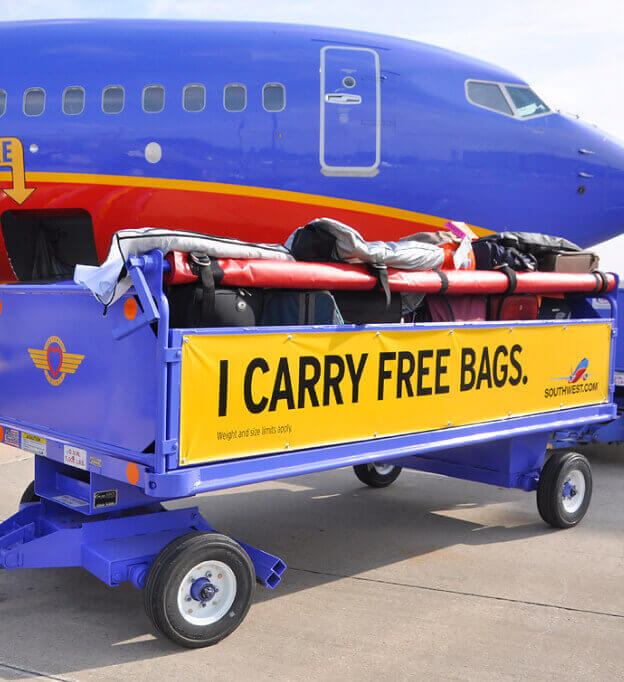
The decision to stick with the bags fly free® policy paid dividends when Southwest attracted new Customers from competitors.
The Great Recession: Challenges and Triumphs
It had been a 35-year run for Southwest. Thirty-five years of profitability. Thirty-five years of growth, becoming the nation’s largest domestic carrier (in terms of domestic originating passengers) after an underdog start as a small Texas airline.
It had been a 35-year run for Southwest. Thirty-five years of profitability. Thirty-five years of growth, becoming the nation’s largest domestic carrier (in terms of domestic originating passengers) after an underdog start as a small Texas airline.
But the global financial crisis of 2008-2009 threatened to put an end to the Company’s historic run of success. Layoff announcements in the business world became a daily occurrence. As consumers and businesses alike were forced to rein in spending, travel took a nosedive. Oil prices soared to nearly $150 a barrel, increasing Southwest expenses by more than $1 billion a year.
The airline industry was already a tough business to navigate without the added stress of a recession. “It’s capital intensive, labor intensive, fuel intensive, intensely cyclical, tremendously competitive,” said Southwest Founder Herb Kelleher. “We figure there’s going to be at least two crises in every decade, and we’d better be ready for them. We manage in good times so that all of us will be protected from bad times.”
In the third quarter of 2008, Southwest posted its first quarterly loss in more than 17 years. But the Company was committed to keeping operating costs low and every Employee on the payroll. Simply cost-cutting its way out of the crisis wasn’t going to be an option. And while the industry approach seemed to involve charging higher fees for checked baggage and raising ticket prices, Southwest was adamant about sticking to its low-fare brand for its Customers.
“A lot of people have been trying to pickpocket and nickel-and-dime their customers,” then-Vice President and Chief Marketing Officer Kevin Krone said in 2009. “We don’t think that’s right.”
Instead, Southwest focused on new income-generating services, upgrading Customer Service experiences, and rethinking flight schedules and aircraft usage as a means of getting the airline back on track toward profitability.
Business Select®, a service that was introduced in 2007, helped Southwest make significant headway. While staying true to the Company’s no-frills, air-travel-for-all Culture, the airline also saw an opportunity to cater to the unique needs of business travelers. For an extra $10 to $30 each way, Business Select travelers enjoyed some extra perks: early boarding, a free onboard premium beverage, and extra Rapid Rewards® points. In 2008 alone, Business Select created nearly $75 million in incremental revenue for the airline.
Southwest evaluated all of its markets for profitability and made adjustments—cutting flights, redeploying aircraft to more profitable markets, and adjusting departure times to meet Customer demand. It also pursued aggressive measures to improve fuel conservation, and the 1 percent improvement gained in 2008 translated to tens of millions of dollars in savings. Southwest began to turn the corner.
One of the airline’s most controversial strategies during the recession was maintaining its bags fly free® policy.
Instead of adopting additional fees like its competitors, Southwest doubled down on its bags fly free policy for the first and second checked bags within weight and size limits and took every opportunity to highlight the value provided to Customers. One flight kicked off with an Operations Agent welcoming Customers with a math lesson: “Ladies and gentlemen . . . I want to give a shout-out to my math teachers for teaching me how to do the following math: I show 137 passengers had 125 bags checked in today for this flight. With what the other airlines are now charging for luggage, I come up with at least $3,250 that you all did not have to pay EXTRA today to travel. Thanks for flying Southwest Airlines.”
The risk paid off. Customer traffic jumped 5 percent in the first quarter of 2009 while Southwest’s top five competitors saw a combined 6 percent decrease. Southwest estimated that 2 to 3 percent of its Customers left other carriers because of the extra fees. And that, Kevin said, was the biggest indicator that the airline was doing something right. “It shows we’re winning, and winning new Customers,” he said. “To us, that’s much more profitable than charging an existing Customer to bring along their luggage.”
By the end of 2008, the recession had pushed six airlines into bankruptcy. But Southwest had managed to turn around a bleak economic situation and report its 36th consecutive year of profitability—a streak unmatched in aviation history.
